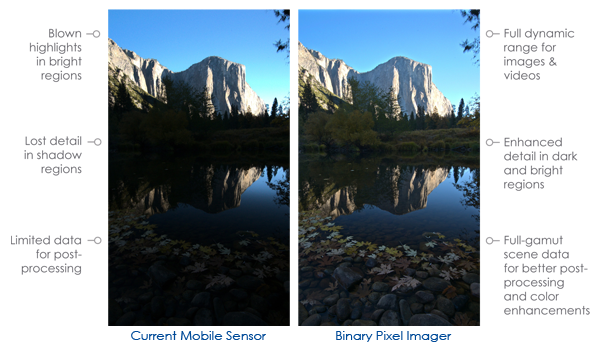Rambus outs Binary Pixel phone camera tech at MWC: 'single-shot HDR and improved low-light sensitivity in a single explosure'

The 'Binary Pixel' invention keeps track of when each pixel has maxed out its light accumulation, then resets it to regain the exposure, thus allowing for HDR photography on the fly without any post-processing to slow things down, and getting around the "saturation point" threshold of current mobile sensors.
Wait, there's more - the method also employs a "Binary Operation" tech, which can vary the photon thresholds, similar to how the human eye fits light and dark clearly in the scene, and also Spatial Oversampling, which combines the results from individual pixels for the best info. According to Rambus, Binary Pixel will bring:
- Improved image quality optimized at the pixel level
- Single-shot HDR photo and video capture operates at high-speed frame-rates
- Improved signal-to-noise performance in low-light conditions
- Silicon-proven technology for mobile form factors
- Easily integratable into existing SoC architectures
- Compatible with current CMOS image sensor process technology
The company has a proof-of-concept CMOS sensor on display at the MWC expo, and here are the possible results from future handsets utilizing the technology.
Breakthrough technology Provides Single-Shot High Dynamic Range and Improved Low-Light Sensitivity in a Single Explosure
SUNNYVALE, CALIFORNIA AND BARCELONA, SPAIN – February 25, 2013 – Rambus Inc. (NASDAQ: RMBS), the innovative technology solutions company that brings invention to market, today unveiled breakthrough binary pixel technology that dramatically improves the quality of photos taken from mobile devices. The Rambus Binary Pixel technlogy includes image sensor and image processing architectures with single-shot high dynamic range (HDR) and improved low-light sensitivity for better videos and photos in any lighting condition.
“Today’s compact mainstream sensors are only able to capture a fraction of what the human eye can see,” said Dr. Martin Scott, chief technology officer at Rambus. “Our breakthrough binary pixel technology enables a tremendous performance improvement for compact imagers capable of ultra high-quality photos and videos from mobile devices.”
As improvements are made in resolution and responsiveness, more and more consumers are using the camera functionality on their smart phone as the primary method for taking photos and capturing memories. However, high contrast scenes typical in daily life, such as bright landscapes, sunset portraits, and scenes with both sunlight and shadow, are difficult to capture with today’s compact mobile sensors - the range of bright and dark details in these scenes simply exceeds the limited dynamic range of mainstream CMOS imagers.
This binary pixel technology is optimized at the pixel level to sense light similar to the human eye while maintaining comparable form factor, cost and power of today’s mobile and consumer imagers. The results are professional-quality images and videos from mobile devices that capture the full gamut of details in dark and bright intensities.
Benefits of binary pixel technology:
Improved image quality optimized at the pixel level
Single-shot HDR photo and video capture operates at high-speed frame-rates
Improved signal-to-noise performance in low-light conditions
Silicon-proven technology for mobile form factors
Easily integratable into existing SoC architectures
Compatible with current CMOS image sensor process technology
The Rambus binary pixel has been demonstrated in a proof-of-concept test-chip and the technology is currently available for integration into future mobile and consumer image sensors. For additional information visit www.rambus.com/binarypixel
SUNNYVALE, CALIFORNIA AND BARCELONA, SPAIN – February 25, 2013 – Rambus Inc. (NASDAQ: RMBS), the innovative technology solutions company that brings invention to market, today unveiled breakthrough binary pixel technology that dramatically improves the quality of photos taken from mobile devices. The Rambus Binary Pixel technlogy includes image sensor and image processing architectures with single-shot high dynamic range (HDR) and improved low-light sensitivity for better videos and photos in any lighting condition.
“Today’s compact mainstream sensors are only able to capture a fraction of what the human eye can see,” said Dr. Martin Scott, chief technology officer at Rambus. “Our breakthrough binary pixel technology enables a tremendous performance improvement for compact imagers capable of ultra high-quality photos and videos from mobile devices.”
As improvements are made in resolution and responsiveness, more and more consumers are using the camera functionality on their smart phone as the primary method for taking photos and capturing memories. However, high contrast scenes typical in daily life, such as bright landscapes, sunset portraits, and scenes with both sunlight and shadow, are difficult to capture with today’s compact mobile sensors - the range of bright and dark details in these scenes simply exceeds the limited dynamic range of mainstream CMOS imagers.
This binary pixel technology is optimized at the pixel level to sense light similar to the human eye while maintaining comparable form factor, cost and power of today’s mobile and consumer imagers. The results are professional-quality images and videos from mobile devices that capture the full gamut of details in dark and bright intensities.
Benefits of binary pixel technology:
Improved image quality optimized at the pixel level
Single-shot HDR photo and video capture operates at high-speed frame-rates
Improved signal-to-noise performance in low-light conditions
Silicon-proven technology for mobile form factors
Easily integratable into existing SoC architectures
Compatible with current CMOS image sensor process technology
The Rambus binary pixel has been demonstrated in a proof-of-concept test-chip and the technology is currently available for integration into future mobile and consumer image sensors. For additional information visit www.rambus.com/binarypixel











Things that are NOT allowed: